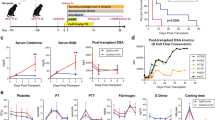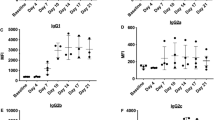Abstract
LYMPHOCYTES which inhibit the immunological responses of other lymphocytes are known as suppressor cells, and such cells have been shown to mediate both specific and nonspecific unresponsiveness in many experimental situations1–3. In the context of allotransplantation, Kilshaw et al.4,5 have found that the highly strain-specific unresponsiveness to skin allografts induced in adult mice by pretreatment with donor strain tissue extract and Bordetella pertussis vaccine, followed by a short post-operative course of antilymphocyte serum (ALS), is at least in part mediated by thymus-dependent lymphocytes. Thus, transfer of 25–100 × 106 spleen cells (optimally the lower dose5) from mice in the stable phase of unresponsiveness into ALS-treated syngeneic recipients established a long-lasting unresponsiveness to donor strain skin grafts in up to 50% of recipients. Because the nature of the mechanisms of immunological enhancement of kidney allografts in rats remain unclear6–8 we have carried out cell transfer experiments similar to those of Kilshaw et al. in order to discover whether suppressor cells also play a part in mediating the stable phase of the enhanced state. Fabre and Morris9 have previously failed to transfer unresponsiveness with spleen cells from rats with enhanced kidneys, but it is possible that transfer of cells to normal, syngeneic rats—as in their experiments—is an insufficiently sensitive method for detecting suppressor cells. Our results show that it is unlikely that suppressor cells or auto-anti-idiotype antibodies are responsible for the steady state of enhancement. A more likely explanation involves the induction of unresponsiveness by the continuous exposure of the recipient to histocompatibility antigens in the absence of Ia-like antigens—the latter determinants being obligatory requirements for the activation of T cells ‘helping’ both potentially reactive B cells and T cells capable of differentiating into killer cells.
This is a preview of subscription content, access via your institution
Access options
Subscribe to this journal
Receive 51 print issues and online access
$199.00 per year
only $3.90 per issue
Buy this article
- Purchase on Springer Link
- Instant access to full article PDF
Prices may be subject to local taxes which are calculated during checkout
Similar content being viewed by others
References
Gershon, R. K. Transpl. Rev. 26, 170–185 (1975).
Tada, T., Taniguchi, M. & Takemori, T. Transpl. Rev. 26, 106–129 (1975).
R. W. Dresser (ed.) Immunological Tolerance, Br. med. Bull. 32, 99–191 (1976).
Kilshaw, P. J., Brent, L. & Pinto, M. Nature 255, 489–491 (1975).
Kilshaw, P. J. & Brent, L. Transpl. Proc. 9, 717–719 (1977).
French, M. E. & Batchelor, J. R. Transpl. Rev. 13, 115–141 (1972).
Batchelor, J. R. & Welsh, K. I. Br. med. Bull. 32, 113–117 (1976).
Carpenter, C. B. d'Apice, A. J. B. & Abbas, A. K. Adv. Immun. 22, 1–65 (1976).
Fabre, J. W. & Morris, P. J. Transplantation 14, 634–640 (1972).
Binz, H., Lindenmann, J. & Wigzell, H. J. exp. Med. 140, 731–741 (1974).
Binz, H. & Wigzell, H. J. exp. Med. 142, 197–211 (1975).
Binz, H. & Wigzell, H. Nature 262, 294–295 (1976).
Binz, H. & Wigzell, H. Nature 264, 778–780 (1976).
McKearn, T. J., Stuart, F. P. & Fitch, F. W. J. Immun. 113, 1876–1882 (1974).
Stuart, F. P., Scollard, D. M., McKearn, T. J. & Fitch, F. W. Transplantation 22, 455–466 (1976).
Anderson, L. C., Binz, H. & Wigzell, H. Nature 264, 778–780 (1976).
Cantor, H. & Boyse, E. A. J. exp. Med. 141, 1376–1389; 1390–1399 (1975).
Klein, J., Livnat, S., Hauptfeld, V., Jerábek, L. & Weissman, I. Eur. J. Immun. 4, 41–44 (1974).
Rolstad, B., Williams, A. F. & Ford, W. L. Transplantation 17, 416–423 (1974).
Eijsvoogel, V. P. et al. Transpl. Proc. 5, 415–420 (1973).
Wagner, H. & Nossal, G. J. V. Transpl. Rev. 17, 3–36 (1974).
Hammerling, G. J. Transpl. Rev. 30, 64–82 (1976).
Welsh, K. I., Burgos, H. & Batchelor, J. R. Eur. J. Immun. 7, 267–272 (1977).
Batchelor, J. R., Welsh, K. I. & Burgos, H. Transpl. Proc. 9, 931–936 (1977).
Hutchinson, I. V. & Zola, H. Transpl. Proc. 9, 961–963 (1977).
Author information
Authors and Affiliations
Rights and permissions
About this article
Cite this article
BATCHELOR, J., BRENT, L. & KILSHAW, P. Absence of suppressor cells from rats bearing passively enhanced kidney allografts. Nature 270, 522–524 (1977). https://doi.org/10.1038/270522a0
Received:
Accepted:
Issue Date:
DOI: https://doi.org/10.1038/270522a0
This article is cited by
Comments
By submitting a comment you agree to abide by our Terms and Community Guidelines. If you find something abusive or that does not comply with our terms or guidelines please flag it as inappropriate.



